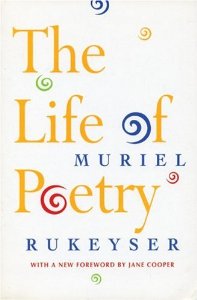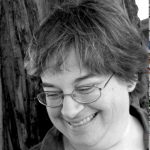Introduction by Carol Dorf
“A Poem Is Not About Anything”

For decades, literary critics have pointed to American poetry's narrow attachment to safe subjects. Yet, the work of Muriel Rukeyser—who was born a century ago in New York City on December 15, 1913—is anything but that. Rukeyser’s poetry remains fresh for the many poets like me who celebrated her centenary.
Rukeyser was much admired by her contemporaries in the 1930s and '40s, when she received numerous honors. But in the post-war period, with its more conservative aesthetics and politics, her work fell out of favor. In the '60s and '70s, her poetry drew new admirers for its political activism and feminism, and she's now receiving well-deserved recognition for her generosity of theme and complex poetics. Her poetic world encompassed science, nature, politics, and gender issues.
The title poem of Rukeyser’s first book Theory of Flight—published as the Yale Series of Younger Poets prizewinner in 1935, when she was just 21—comes from the instruction manual for the flight lessons she took when she was barely out of her teens. Although her parents wouldn't allow her to get her pilot's license, flight became a transformative metaphor in the poems.
In U.S.1, her second book, published in 1938, the central poem is a long sequence called "The Book of the Dead." In it, she writes of the illness and death of miners in Gauley, West Virginia, due to silicosis. The poem combines lyric and narrative poetry, documentary evidence, and verse in the voices of those involved.
When I first read U.S.1, the sure hand of this very young poet amazed me. I discovered Rukeyser's poems long after college, but now I think how much more alive poetry of the 1930s would have seemed if I'd read that poem in the classroom. Here's a segment of the short, lyric section called "The Dam," which provides a break in the grim narrative of the corporation's attempted cover-up of the silicosis epidemic:
All power is saved, having no end. Rises
in the green season, in the sudden season
the white the budded
and the lost.
Water celebrates, yielding continually
sheeted and fast in its overfall
slips down the rock, evades the pillars
building its colonnades, repairs
in stream and standing wave
retains its seaward green
broken by obstacle rock; falling, the water sheet
spouts, and the mind dances, excess of white.
White brilliant function of the land's disease.
 I admire the way a combination of vivid images—"standing wave/retains its seaward green"—and sounds propel the poem. The final line serves to stop the progression of the lyric moment, reminding the reader of the central issue of the poem.
I admire the way a combination of vivid images—"standing wave/retains its seaward green"—and sounds propel the poem. The final line serves to stop the progression of the lyric moment, reminding the reader of the central issue of the poem.
Many factors led to Rukeyser’s eclipse in the 1950s as a leading poet. The Red Scare made it harder for her, a leftist and an activist, to find both publishers and academic jobs. Unmarried, she’d had a son in 1947 and raised him as a single mother, a radical act for that era. Poetry criticism shifted to looking at poems in isolation from their context, and Rukeyser’s work requires context to achieve its impact. And in 1964—at the age of fifty and at the start of an era that could have been more receptive to her poetry—she had a stroke.
Still, throughout all this, she continued to write poetry, biographies, criticism, and even an opera, while remaining engaged in the issues of the day. She taught at a number of institutions, including the California Labor School and Sarah Lawrence College. Poets as diverse as Kimiko Hahn, Joan Larkin, Sharon Olds, Alicia Ostriker, Gerald Stern, and Brian Teare have discussed her influence on them.
Rukeyser's work does not fit easily into anthologies; some of her best poems are longer works—such as the "Lives" poems, which include "Akiba" and "Käthe Kollwitz"—or they are part of a series of related poems that she organized into books, such as "The Book of the Dead" or "The Gates." I’m excited by the possibility of the long poem in my own work and with weaving together lyrical, narrative, and documentary elements into a whole.
I also appreciate Rukeyser’s thoughts on revision from this 1978 interview with Pearl London at the New School in New York:
I've been very superstitious about not talking about work in process. It's been very bad luck for me; the work is not formed until after that moment, and I haven't even talked to the people I've loved the best, I haven't shown poems as they were being made, most of all I haven't liked to talk about, as people say, what they're ‘about.’ A poem is not about anything, as you who have been working in poems surely know. It is informed by certain things. It's very hard to talk about the rewriting that goes into them because the major rewriting is likely to be in the matter of sound, the sound that is deep in the structure, almost a crystalline structure of sound in the poem.
While many materials become part of a poem, what links them is the series of sounds given shape by the poet. In our era of the workshop and reading works in progress, her cautionary note about sharing poems before they've come together is worth considering.
Rukeyser's approach to poetry incorporates science and the events of daily life. In my own writing, I find that the math I teach finds its place in my poems—even the love poems and elegies. A little more than a year ago, when a dear friend was dying of cancer, I found that the science we both loved gave me an entry point into the poems I wrote about the experience.
 As Rukeyser expressed in her 1949 nonfiction book The Life of Poetry, these juxtapositions of fact and feeling are necessary for those of us who want to make more space for poetry in the day's conversation.
As Rukeyser expressed in her 1949 nonfiction book The Life of Poetry, these juxtapositions of fact and feeling are necessary for those of us who want to make more space for poetry in the day's conversation.
In Talking Writing, we publish poets who work from a wide variety of aesthetic points of view. What their writing shares, however, is a perspective that steps beyond the narrow, safe constraints of craft and topic. The spotlight poems in TW’s Winter 2014 issue are no exception. They pay tribute to Rukeyser’s full involvement with and deep concern about the role of poetry in conveying meaning for its readers.
We are delighted to begin this spotlight series with Alicia Ostriker's "Ode to New York City"—a love poem to a place that animated Rukeyser as well. Several other city poems also found their way into this issue, including Julia Stein's "Coming Home" (about Los Angeles) and Dawn McGuire's "65th and Telegraph" (on the border between Oakland and my hometown of Berkeley, California).
Beth Marzoni's poems about border crossing reflect Rukeyser's lyrical and documentary strengths. Yvonne Estrada's "In the Balance" brings city life together with parenting and finding ways to teach our children empathy. Katharine Harer's "How to Hope" emphasizes another kind of empathy.
Anita Barrows’s lyrical poem "Lesson from Darkness" focuses on preserving the present for the next generation, another primary concern of Rukeyser’s poetry. And Eric Dickey's poem "Going to D.C." reveals the way war enters our dreams.
I'd like to end with a few lines from section 15 of Rukeyser's long poem “The Gates.” The poet, dealing with the aftermath of a series of strokes, stands in front of the gates of the prison where North Korean poet Kim Chi Ha waits, having been condemned to death for his writings:
All day the rain
all day waiting within the prison gate
before another prison gate
The house of the poet
. . .
I have arrived at the house of the poet
in the mud in the interior music of all poems
and the grey rain of the world
whose gates do not open.
I stand, and for this religion and that religion
do not eat but remember all the things I know
and a strong infant beginning to run.
Nothing is happening. Mud, silence, rain.
Typical of Rukeyser, she brings together in this fragment some of the larger themes of the poem as a whole. She combines image and sound in lines like "the grey rain of the world/whose gates do not open."
While this poem ends with "Nothing is happening," Rukeyser's own legacy is full of event. She spent her life in the places where history's motion is visible, and we are fortunate recipients of that legacy.
TW Winter 2014 Poetry Spotlight: Honoring Rukeyser
Alicia Ostriker: "Ode to New York City"
Beth Marzoni: "Anecdotes of the Border Crossing"
Yvonne Estrada: "In the Balance"
Anita Barrows: "Lessons from Darkness"
Eric Dickey: "Going to D.C."
Katharine Harer: "the next war" and “How to Hope”
Julia Stein: "Coming Home"
Dawn McGuire: "65th and Telegraph"
Editor’s Note: Links will be activated as poems publish throughout the issue cycle.
Starting Points for Muriel Rukeyser
Books
A Muriel Rukeyser Reader, edited by Jan Heller Levi with an introduction by Adrienne Rich (W.W. Norton, 1995), contains a well-thought-out selection of Rukeyser's writing that spans her 45-year writing life and includes prose as well as poetry.
Muriel Rukeyser: Selected Poems (American Poets Project), edited by Adrienne Rich (Library of America, 2004), includes additional reflections by Rich on Rukeyser's work and a good selection of her poems.
Online Resources
Muriel Rukeyser: A Living Archive is the best starting point to the world of Rukeyser. The site contains a selection of Rukeyser's writings, as well as essays and blog posts by writers and critics.
Poetry Daily republished Marilyn Hacker's profile of Rukeyser (originally published in Poetry London in 2004), which provides a useful overview of her works.
Penn Sound, a project of the Center for Programs in Contemporary Writing at the University of Pennsylvania, offers three readings by Rukeyser: “Poems and Commentary by Muriel Rukeyser, March 21, 1959”; “Reading at the University of Warwick, 1971”; and “The Poetry and Voice of Muriel Rukeyser, Caedmon, 1977.”
Publication Information
- Theory of Flight by Muriel Rukeyser, foreword by Stephen Vincent Benet (Yale University Press, 1935).
- U.S. 1 by Muriel Rukeyser (Covici, Friede, 1938).
- The Gates by Muriel Rukeyser (McGraw-Hill, 1976).
- The Life of Poetry by Muriel Rukeyser (Current Books, 1949; republished by Paris Press, 1996).
- Muriel Rukeyser interview with Pearl London at the New School in New York, February 1978, published in Poetry In Person, edited by Alexander Neubauerb (Knopf, 2010). Many prominent poets were part of the public interview series, including Maxine Kumin, Robert Hass, Philip Levine, Louise Glück, and June Jordan.
- “On Definitions” by Carol Dorf, one of the poems written about the death of her friend. Published in Antiphon, Spring 2012.
Art Information
- "Muriel Rukeyser" © William L. Rukeyser; used courtesy of William L. Rukeyser.
- "Plane Sailing" © Wynand Van Niekerk; stock image license.
 Carol Dorf is the poetry editor at Talking Writing. Her poems have been widely published and anthologized.
Carol Dorf is the poetry editor at Talking Writing. Her poems have been widely published and anthologized.
Carol has taught in many venues, including a science museum, a large urban high school, as a California-Poet-in-the-Schools, and at Berkeley City College.
